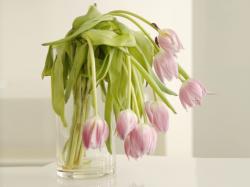Post Production Research: Cut Flower Longevity
July 6, 2010 | 2 min to read

BACKGROUND
Cut flower longevity is often reduced by an accumulation of bacteria in floral solutions and flower stems. Chlorine dioxide (ClO2), a broad spectrum bactericide commercially used for sanitizing fruit and vegetable surfaces, was tested to determine its potential use as an antimicrobial agent for fresh cut flower stems and solutions.
MATERIALS AND METHODS
Flowering stems of Alstroemeria, Snapdragon, Delphinium, Carnation, Chrysanthemum, Gerbera, Gypsophila, Asiatic Lilies, Stock, and Roses were obtained from production areas in California or Colombia and commercially transported to the University of Florida postharvest laboratory within 2 to 7 days after harvest.
Various concentrations of ClO2 used for treatments were prepared by diluting a 500 ppm stock ClO2 solution (Selectrocide™ 2L500; Selective Micro Technologies, LLC, Beverly, MA, USA) in deionized water. In the first study, stems were held in ClO2 concentrations of 0, 2, 5, 10, 20 and 50 ppm to determine the optimum effectiveness of the product.
A second study evaluated the effectiveness of adding 10 ppm ClO2 to vase solutions with known concentrations of bacteria previously isolated from vase water from each flower species. In addition, we tested the effectiveness of a farm-level ClO2 hydration and stem dips (10 ppm for 1 minute) and the efficacy of ClO2 vase water treatments compared to other biocides. Vase life and quality of all studies were evaluated at 70 °F, 70 ftc (12 hrs/day) and 50% relative humidity.
RESULTS
A 2 ppm concentration of aqueous ClO2 was optimal for extending vase life of Stock, while 10 ppm of aqueous ClO2 was most effective for prolonging vase life of the other responsive flower species. The highest concentration of 50 ppm reduced vase life for Delphinium and Chrysanthemum and accelerated leaf chlorosis on Alstroemeria and Lilies.
Adding low concentrations (2 to 10 ppm) of aqueous ClO2 to deionized vase water significantly extended the display life of Alstroemeria, Snapdragon, Carnation, Gerbera, Gypsophila, Asiatic Lilies, Stock, and Roses (Photos 1 & 2). Vase life increased by 0.9–13.4 days (7–77%) compared to flowers not held in ClO2.
CONCLUSIONS
Chlorine dioxide was very effective in reducing bacteria in solutions, increasing vase life from 7 to 77% in 8 of 10 flower species tested, showed similar levels of efficacy to 8-HQS, and was more effective than all other tested biocides.
IMPACT TO THE INDUSTRY
ClO2 is an effective treatment for controlling bacteria in vase solutions and extending cut flower longevity of many popular fresh cut flower species.
Research performed by:
A.J. Macnish, Postdoctoral Researcher,
T.A. Nell, Professor and Chairman,
R.T. Leonard, Biological Scientist, and
A.M. Alexander, Biological Scientist
Department of Environmental Horticulture, University of Florida, Gainesville, 32611
Contact: tanell@ufl.edu
Source: American Floral Endowment
